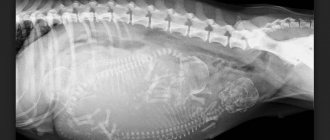Probably, all beagle owners would like their pets to produce healthy and beautiful offspring. This needs to be approached with increased responsibility and attention.
You should find out in advance all the details of mating dogs of this breed: features of estrus, what is the ideal time for mating, how to care for a bitch during pregnancy, and other equally important issues.
Childbirth in dogs
Dogs give birth to an average of 5-6 puppies.
During childbirth, under no circumstances should the female dog be left unattended. It is optimal if you have help, since sometimes puppies are born one after another. If any of them turns out to be weak, then it will be difficult for you to simultaneously help the dog and revive the weak puppy. Typically pregnancy lasts 58-66. Pay attention to signs that labor is approaching:
- A few days before giving birth, the dog begins to “dig”, sometimes tears up the bedding, is reluctant to go for a walk, and may refuse to eat.
- 2-3 days or several hours before birth, thick brown mucus comes out of the loop.
- 6-20 hours before birth, the loop becomes loose, soft, and sags.
- 12-24 hours before birth, the temperature drops to 37°C or lower.
- 2-3 days before giving birth, the dog may often ask to go for a walk or even urinate at home.
With the onset of contractions, the dog becomes restless and often licks the noose. During the first stage of labor, the cervix opens and the birth canal and loop further soften. During the contraction, which usually lasts 10-30 seconds, the dog breathes heavily with its mouth open, then calms down for a few minutes until the next contraction.
When the cervix is fully dilated, the second stage of labor begins - pushing, the birth of puppies. Even in a small female dog, with good labor activity, large puppies are born alive.
During pushing, the dog lies on its side, sits down like a big dog, or sits down, leaning its side against the wall. In this case, at first only a strong tension in the abdominal muscles is noticeable, the dog suddenly stops breathing heavily and closes its mouth. Then, during pushing, the tail rises. Now there are only a few minutes left until the puppy is born. And finally, the skin under the tail tenses, stretches, and the puppy is born. It is a common belief that the dog will do everything on its own and there is no need to interfere with it. However, during a multiple pregnancy, the dog at the beginning of labor cannot reach the loop and help the puppy free itself from the amniotic sac. The first thing you should do is quickly open the amniotic sac with your fingernails, if it does not burst on its own during pushing, and immediately cut the umbilical cord with clean, blunt scissors or break it with your fingernails at a distance of approximately 3 cm from the puppy's tummy. In this case, you should not pull the umbilical cord from the puppy's side, as this can lead to the formation of an umbilical hernia. When using sharp scissors, the umbilical cord will bleed longer. In addition, you risk injuring your puppy, dog, or yourself with scissors if the dog moves suddenly or unexpectedly. There is no need to lubricate the umbilical cord with iodine; it dries out on its own after a few hours.
A newly born puppy should be vigorously rubbed with a clean, dry cloth and given to the dog, who will lick and massage it. After this, place the puppy next to the mother, and after 2-3 minutes the puppy will be suckling. A puppy born without signs of life must, first of all, clear the airways of mucus and amniotic fluid and rub it vigorously with a dry cloth. Holding your puppy head down, use two fingers to quickly and rhythmically squeeze the sides of his chest. If mucus appears again from your mouth and nose, suck it out. Try mouth-to-mouth artificial respiration. But do this very carefully so as not to rupture the puppy's lungs with air. You can dip your puppy alternately in cold and hot water.
Source
What determines the number of puppies in a litter?
Neither the owner himself nor the veterinarian will be able to guess just by looking at a pregnant bitch how many fetuses are in her womb. However, you can try to find out how many puppies a dog can give birth to, based on the following data:
- Dimensions (breed) of a pregnant dog. As a rule [1], the number of puppies per litter is higher for large breed dogs (7-8 or more) because, from a biological point of view, they can safely bear more puppies. Miniature pets usually give birth to 1 to 4 babies. Although there are exceptions to this rule. There is evidence that some baby Pekingese can give birth to up to 10 puppies;
Bitch's age. Usually there are few puppies in young dogs under the age of 1.5 years (1-2 puppies in small breed dogs and no more than 4 in large breeds). And dogs over 5-6 years old, as a rule, also have few babies in their litter. Maximum [1] puppies are born to bitches who are between 2 and 5 years old;
Male age. The number of puppies also depends on how old their father is [1]. Young males aged 1-1.5 years and older dogs have low sperm quality, which affects the number of offspring;
Order of birth. The first time, bitches, regardless of age, give birth to fewer puppies than the second time. And the third or fourth births account for the most numerous litters [1]. After this point, litters tend to get smaller with each successful mating. For example, tiny Chihuahuas in the first litter produce no more than 2 babies, and in the third they can already give birth to 3-4 cubs;
The dog's health during pregnancy and before birth. Everything is simple here: the physically stronger the dog, the stronger its immunity, the higher the chances that it will be able to safely bear a large number of puppies. Thus, a healthy small mongrel is capable of giving birth to more puppies than a purebred large dog, whose condition leaves much to be desired. Ideally, before mating, the owner should show his four-legged pet to a veterinarian and make sure that everything is in order with her health;
Dog's weight. Few puppies in a litter usually occur in dogs whose weight is far from normal. Moreover, this applies to both animals with insufficient body weight and pets with obesity;
Season. There is evidence [1] that in the spring bitches give birth to a larger number of cubs in comparison with other times of the year (the smallest number of doggies is born in the cold season, that is, in late autumn and winter);
- Natural or artificial fertilization (insemination). Almost always [2] with natural insemination, when a bitch has contact with a male, more puppies are born in the litter than with artificial insemination. This is due to the fact that during artificial insemination, sperm partially die during the collection and storage of the male’s semen.
Announcement
WELCOME TO THE BEAGLE BREED LOVERS FORUM!
You are a Newbie and only 15 days from the moment of registration on the forum and 30 messages separate you from the next status and remove all restrictions, more >>
ATTENTION! You cannot leave comments in the PUPPIES sections! comments from the topic author are allowed!
ATTENTION! You cannot leave comments in the PUPPIES sections! comments from the topic author are allowed!
ATTENTION! You cannot leave comments in the PUPPIES sections! comments from the topic author are allowed!
ATTENTION! You cannot leave comments in the Let's take a beagle into good hands section! comments from the topic author are allowed!
ATTENTION! You cannot leave comments in the Stud dogs section! comments from the topic author are allowed!
Varieties
Officially, the American Kennel Club distinguishes two types of beagles - English and American. The first type may be called differently in different sources. For example, French or European. The main visual difference is the size. The American brother is noticeably larger than his relative from Foggy Albion. Other differences between the two types are shown in the table.
Table - Comparative characteristics of English and American beagles
| Characteristic | English | American |
| Maximum height at withers | 33 cm | 41 cm |
| Scull | Rounded | Angular |
| Body | Knocked down, streamlined | Muscular |
Unofficially, there is another type of breed - dwarf. In the 18th century, such beagles were carried on horses in special hanging bags. Offers to buy a dog with a height at the withers of less than 28 cm can still be found today. But be aware: height below standard may indicate the presence of a genetic disease in the puppy. The English Kennel Club believes that the breed under discussion does not have any internal division into subspecies.
Posts 1 page 10 of 10
Share105.02.2012 14:15:15
- Author: Lana-2 (Asta-Julie)
- Nursery "Holyland Beagle"
- From: Jerusalem
- Registered: 12/17/2006
- Posts: 8382
- Female gender
- Age: 49 [1972-08-20]
- Last visit: 10/18/2015 15:38:35
More than once I have heard different statements from forum users about the large number of puppies born.
In addition to being happy for the litter, some breeders express bewilderment at the number of puppies left alive.
Beagle pregnancy and childbirth
The health of the child depends on the course of pregnancy in the mother and on the health of both parents - this applies equally to both people and dogs. To obtain healthy offspring, the owner of the bitch, and especially the breeder, should familiarize themselves in advance with the details of pregnancy management and possible mistakes.
Beagles - specific diseases that cause difficulties with pregnancy and childbirth . Owners often think that procreation is a natural process, which means there can be no failure, even if the dog is left alone. The statistics are that the mortality rate among bitches and puppies left without obstetric care is much higher than among those who received medical care. Particular attention should be paid to protection against infections - this is the most common cause of death in children.
Breed standard
Weight - from 8 to 11 kg. Height at the withers is 33-41 cm. Males are slightly larger than females and more powerfully built. Color may vary significantly. The classic three-color color black/red/white and two-color white and red are common. All colors can be spotted. The tip of the tail is white. The coat is thick, smooth, lying close to the body. It protects well from bad weather without allowing moisture to pass through. There are varieties of the breed. European beagle and American. The difference is in color, the American beagle is slightly larger than the European one.
Where does it all begin?
The Beagle 's
first heat occurs at the age of 6–12 months, but this does not indicate full maturation of the body. to breed beagles after two years: veterinarians recommend waiting until the third heat and planning reproduction only then - at this point the dog, with proper care, is ready to give birth. Pregnancy in Beagles lasts on average 60 days, but a period from 53 to 71 days is not considered a deviation from the norm. Signs of a successful mating, that is, pregnancy, are:
- change in eating behavior: the bitch may begin to eat more than usual, or less (a more common sign);
- change in habits - when pregnancy occurs, many dogs become less active and sleep more;
- swelling and redness of the nipples - noticeable already after 2-3 weeks;
- abdominal enlargement - becomes visible after 4-5 weeks.
Three weeks after fertilization, the onset of pregnancy can be determined by the level of the hormone relaxin in the blood, and after the fifth week, ultrasound will provide reliable information. These examinations must be completed to exclude false pregnancy.
Diet
Representatives of the breed are unpretentious in food. Babies need to be fed four to five times a day. The transition to twice a day feeding should be made only after the pet is 12 months old. You can feed your beagle both special dry food and natural food. Typically, dog owners choose a diet based on their own convenience.
- Dry food. The speed of food preparation is one of the main advantages of the food. In addition, high-quality dog food, packaged in portioned bags, contains all the necessary vitamins, minerals and trace elements. But buying quality food is a powerful blow to the family budget. This should be taken into account when making a choice.
- Natural food. This concept usually means a variety of porridges with meat and vegetables. This is more profitable than elite food, but preparing porridge will take a lot of time. In addition, during the cooking process, proportions must be strictly observed. Meat ingredients in a pet dish should be 70%, porridge - 25%, vegetables - 5%.
- Water. There should always be clean drinking water in the place where the dog usually eats. Even if your four-legged friend has not drunk it, the water must be renewed every two days. Drinking for active dogs is important at any time of the year, but especially in summer.
- “No” to fatty foods. Beagles are strictly prohibited from eating fatty foods, as well as fried foods, which owners often feed their pets from the table. These dogs are prone to obesity. When treating your pet to “something tasty,” remember: you are only making it worse for him.
Beagle puppies need to be fed fermented milk products. Once a week, veterinarians recommend treating them to fresh cottage cheese.
Danger: false pregnancy
Bitches of all breeds are susceptible to this disease, and the beagle is no exception: after mating , signs of pregnancy appear (even to the point that the dog begins to “build a nest” for childbirth), despite the fact that fertilization has not occurred. The physical symptoms are consistent with those of a real pregnancy—the belly may even become larger. Most often, this condition goes away on its own within 2–3 weeks, but in severe cases, hormonal treatment is required. If you are affected by this problem, do not take action on your own - consult your veterinarian.
Estrus
Beagles' estrus lasts from 7 to 28 days and occurs 2 times a year. The first 8 days are the beginning of estrus. At this time, the dog's body is subject to hormonal changes. The genitals are slightly swollen. There is slightly noticeable bleeding.
The most favorable time for mating is from 10–15 days, lasting 7–10 days. During this period, changes in behavior occur: it becomes disobedient, begins to show attention to male dogs and, when meeting, moves its tail to the side. This is when mating is done.
Next comes “calm.” It occurs approximately on the 16th day from the start of estrus and lasts up to 30 days. The dog does not allow males to approach him.
The first heat can occur at six months. You should especially monitor your dog and remember that pregnancy and childbirth for up to a year are harmful to the body.
The absence of estrus in your pet or its occurrence more than 2 times a year indicates hormonal imbalances and the need to visit a veterinarian.
Nutrition for the expectant mother
A pregnant beagle needs a higher calorie diet with more nutrients than usual. Choose a food specifically tailored for expectant mothers and increase portions by 10% weekly. If you feed your dog natural products, you should gradually change the proportions, increasing the amount of meat in the diet by reducing the amount of carbohydrates and fiber. From cereal feeds, add wheat - this is a source of vitamin B. Raw yolks and fish oil are needed. During pregnancy, your pet needs dairy products, but during longer periods of time, the calcium content in the food needs to be reduced.
As the puppies develop in utero, the daily diet is gradually split up, giving food in small portions, but more often (starting from the 4th week - this is 4 feedings a day).
Important: the dog does not require fortified and calcified supplements during the gestation period; it must receive all nutrients and minerals naturally - from food. Hypervitaminosis is dangerous for developmental pathologies in offspring, and excess calcium leads to disruption of the metabolism of magnesium, phosphorus and zinc, which are necessary for both mother and children. It is permissible to introduce additional complexes of substances into the diet only as prescribed by a veterinarian.
Accurate ways to find out the number of puppies
Of course, you can't rely entirely on a dog's age and, say, its weight to know how many puppies there will be in a litter. More reliable information can be obtained using an ultrasound, which is performed on bitches after the 25th day of pregnancy (veterinarians sometimes use ultrasound only to confirm pregnancy, and not to count the number of puppies). You can even more accurately determine the number of puppies using x-rays, but such a study is most informative only after the 55th day of pregnancy, when the skeleton of the puppies is fully formed. By the way, during the X-ray examination, the doctor will determine the position of the fetuses and decide whether the dog will need help during childbirth.
By the way, some owners, trying to calculate the number of fetuses in the dog’s womb, use the palpation method by pressing on the belly of their pregnant pet. You shouldn't do this! And not only because it is very difficult to find puppies. Just strong pressure can damage fragile babies, as well as cause pain to a pregnant animal.
Preparation
Three weeks before the expected date of birth, it is necessary to equip a place where the bitch can “build a nest” for the puppies - an enclosure with bedding or a playpen. The dog should be washed 10–7 days in advance - carefully so as not to cause discomfort, damage the stomach or catch a cold. Then start measuring your temperature three times a day (normally it is about 38 °C). Exercise is still required, but do not let the expectant mother off the leash (most likely, she herself will not want to be active and walk for a long time).
The approach of childbirth in a beagle can be determined by a number of signs:
- a sharp drop in temperature to 36.5–36.8 °C for several hours - indicates that the bitch should give birth in a day or two, otherwise you need to urgently consult a doctor (a caesarean section may be necessary);
- decreased appetite - the dog may refuse food a day or two before giving birth;
- swelling of the mammary glands and release of colostrum;
- separation of the mucous plug - as a result, discharge from the loop (a day or three before birth);
- atypical behavior of the bitch - she can look for a secluded place or, on the contrary, actively demand affection, “dig” the litter;
- rapid breathing and heart rate;
- training contractions (muscle contractions that help the cervix open).
Selection of ready-made food
Industrial food for pregnant and lactating dogs should be purchased premium or super premium. Specialized food for puppy dogs is recommended; food for puppies is also suitable. The recommendations on the product packaging must be strictly followed.
If until now the dog has been eating “natural” food, it is impossible to switch it to dry food during pregnancy: the body experiences stress and is being rebuilt, and you should not add to this the need to adapt to a different diet.
It is also undesirable to change the brand of food. Choose a product from the same line, only intended for pregnant and lactating bitches.
The exception is if you fed the animal with economy class food. Then it’s worth switching your dog to premium dry food for pregnant dogs.
Responsible moment
To be prepared for childbirth and not get confused, it is better to prepare everything you need in advance:
- sterile diapers, gauze and napkins;
- dry towel;
- scissors with rounded edges (the dog can move actively, there is a risk of injuring it or the puppies);
- antiseptic;
- clean oilcloth;
- medical gloves;
- electronic scales, notepad and pen;
- colored threads - mark puppies;
- silk thread (put in a disinfectant solution);
- a box with a warm heating pad.
If you deliver your dog yourself, keep your veterinarian's phone number handy!
Beagle labor lasts from several hours to a day . The process can be divided into three periods.
- Start of contractions. The cervix opens and the birth canal softens. The contraction normally lasts from 10 to 30 seconds, between them the dog rests and calms down.
- Loss of amniotic fluid, pushing and, in fact, the birth of babies. This is a very painful process, so the owner must give the dog maximum attention. During a multiple pregnancy, the mother in labor cannot always reach the amniotic sac and free the puppy from it - in this case, you need to quickly and carefully open the amniotic sac and cut the umbilical cord without pulling it. The umbilical cord is tied with silk thread.
- After each puppy, the placenta and membranes leave the placenta; instinct dictates to the dog to eat it. There is no consensus among veterinarians as to whether eating afterbirth is beneficial. It’s better not to let it all be eaten, as this can lead to stomach upset. Check whether the placenta came out after the last puppy - if it is not removed, inflammation will develop (if the placenta does not come out within a few hours, a doctor's intervention is required).
Beagles , as a rule, give birth to 4 to 6 puppies (the first time less, most often two). The mother should sniff and lick the puppy. After this, rub it with a dry towel and put it in a box with a heating pad. Let the box be in plain view of the dog so that it does not worry.
When all the puppies have been born and the placenta has come out, place them next to their mother - after 2-3 minutes they will begin to suckle. This will mean that everything is in order, and you have several interesting months ahead of watching the little beagles grow up.
Mating
Puberty in Beagles occurs quite early, at approximately 6–12 months. It is worth remembering that pregnancy is a great stress, which can be destructive for a young, not yet strong body, and bring with it many diseases. Therefore, according to the requirements of the RKF, the first mating is carried out no earlier than from the 2nd heat upon reaching the age of 15 months.
Selecting a dog for mating is a very labor-intensive process, and knowledge about this cannot be done without it. It is advisable to consult with an experienced breeder on this matter, or better yet, with several.
When selecting a male dog, it is recommended to rely on certain arguments: correct proportions and volume of the head, exterior, stable psyche, quality of his offspring, pedigree.
Make a list of applicants so that the male covers the female's shortcomings in body structure. There is no need to rush and go and look at each one in person. First, study each candidate more carefully. First of all, analyze the dog's body structure. Find out about previous offspring and compare all the results obtained.
Now you can study the pedigrees. There is a possibility that some will be related to your bitch. They can also be ignored, because mixing of blood (inbreeding) in animals is just as unacceptable as in humans.
The list has noticeably shortened. You can go and “get to know” the applicants. Don’t be shy and examine the dog: examine his mouth, feel his testicles, etc. Does he live up to the advertisement? If the owner has nothing to hide, he will not interfere with the inspection. If not, then feel free to move on to the next candidate.
Now you need to make the final choice and set a mating date. What happens next is no longer up to you. All you can do is prepare the bitch by giving her enough attention, nutrition and care.
Possible difficulties
If a beagle gives birth for the first time, difficulties may arise due to lack of experience:
- if the puppy was born without signs of life, you need to clear his respiratory tract from mucus, check if his tongue is stuck, rub it, make sure he is breathing and place it next to his mother before new attempts begin;
- if a puppy is stuck in the birth canal and there is no doctor nearby, you will have to help him be born: this is his only chance to survive. To do this, carefully release your head and shoulders, having first wrapped your hands in gauze so that they do not slip;
- if the dog does not show initiative towards the newborn , bring it to its muzzle; as a rule, beagle quickly understand what is required of them;
- if the puppy was born dead, you will have to carefully but quickly pull it out, otherwise the others will suffocate.
These measures are emergency: if possible, a doctor should be present at the birth. But an attentive owner can also help the pet produce offspring. The birth of babies is a serious physical and mental stress: prepare informationally and mentally, because your calmness and correct actions are an important component of success.
Source
What foods should not be given?
You can't give milk to your dog. Lactose is poorly absorbed by adult carnivores and can lead to digestive upset.
Food containing dyes and flavor enhancers should not be used to feed a pregnant dog. These include economy-class industrial feed.
All “doubtful” products, which are undesirable at other periods of the animal’s life, but acceptable, should now be strictly excluded. For example, pearl barley porridge and the like.











